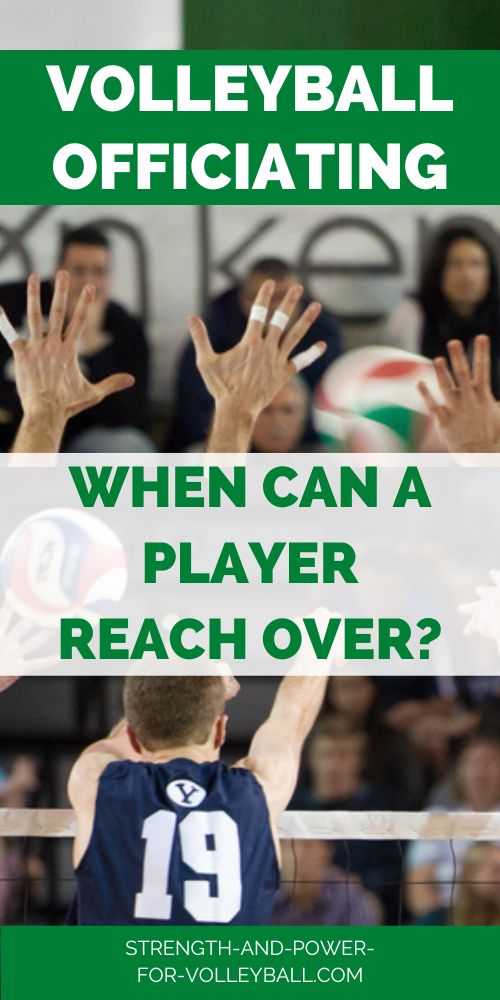Over the Net in Volleyball
Rules for Reaching Over
Over the net in volleyball. Do you know the rules for reaching over? Use these tips for winning more rallies by knowing the over the net rule.
Blocking Rule for Reaching Over the Net in Volleyball
There are 4 situations where it's legal for a front row player to reach over the net and block the ball. All these situations are for when the ball hasn't broke the vertical plane of the net and the entire ball is on the other side.
- After 3 contacts. A player can reach over the net and block the ball after the opponent has made 3 contacts. This is true for the situation of reaching over and blocking the ball. This isn't for reaching over and attacking the ball.
- The opponent has another contact, but there isn't anyone there to play the ball. If, in the referees judgement, no one on the opposing team could have made a play on the ball if the blocker hadn't touched the ball, then the blocker can legally reach over the net to block.
- The ball will come across the net anyway. If, in the referees judgement the ball would have crossed the vertical plane of the net, then it's legal to reach over and block the ball before it enters the vertical plane of the net. If the ball isn't going to cross and the opponent still has another contact available and there's someone there to make the play, then this would be illegal to reach over and complete the block.
- The opponent completes an attack. If the opponent is sending the ball towards the other team and the blocker at the net reaches over and makes contact with the ball that's completely on the other side, this is legal since the opponent has attacked the ball. A front row player can reach over and block any ball that's legally attacked.
It's important to know the rules. If you don't know the rules, don't just assume you can't legally reach over the net. There are situations where you can legally reach over, so it's to your advantage to be aware of these situations so that when they occur you can take advantage of the rules.
Attacking Rule for Reaching Over the Net in Volleyball
There isn't any situation in volleyball where any player on the court can reach over the net and attack a ball that is entirely on the opposite side of the net. It's the referees judgement whether or not the ball has entered the vertical plane of the net. If the ball breaks the plane, anyone can attack or block the ball.
Advantage of Knowing the Rules for Reaching Over the Net in Volleyball
If you understand the rules for reaching over the net in volleyball, you'll have a big advantage over the players, teams, and coaches that don't understand the rules.
For example, if you understand that anyone can play a ball that's entered the vertical plane of the net, then you won't be afraid to hit the ball when the ball enters the plane.
Many people don't understand that even though a setter is trying to set a ball that's entered the plane, the opposing player can legally attack or block this ball.
If the setter is back row, the setter is in danger of illegally attacking or illegally blocking the ball.
A smart play would be for a blocker to touch a ball that's in the vertical net plane that's being set by a setter. If both players are contacting the ball at the same time, and back row player has part of their body (their hands) above the net at the moment of simultaneous contact, then this is an illegal back row block by the setter.
So, in this situation, it's important for the setter to know they are at risk of illegally back row blocking a ball that is in the plane of the net (when there is an opponent there that could block the ball).
Also, it's wise for the front row players to know the rules for reaching over the net in volleyball, because this is an opportunity to win more rallies by knowing what to do in this situation.
Also, for this situation, the back row setter is at risk of illegally attacking the ball. If, at the moment of contact, the entire ball is above the top of the net, the setter can't send the ball over the net.
For example, if the back row setter were to attempt an athletic play on the ball for a ball that's passed tight to the net, the setter needs to be aware of the fact they can't send the ball over the net (when at contact, the entire ball is above the net). This would be an illegal back row attack.
For the situation where the back row setter is saving the ball that's above the net, if the ball is set to a teammate and if the ball is in the vertical net plane and is touched first by the opponent, then this is an illegal back row attack. If the ball is attacked by the teammate, then the play is legal.
If you enjoyed these tips on the rules for over the net in volleyball and would like to keep them close to you at any time, just save this pin to your Pinterest Volleyball Training Board.
Your second block of text...
